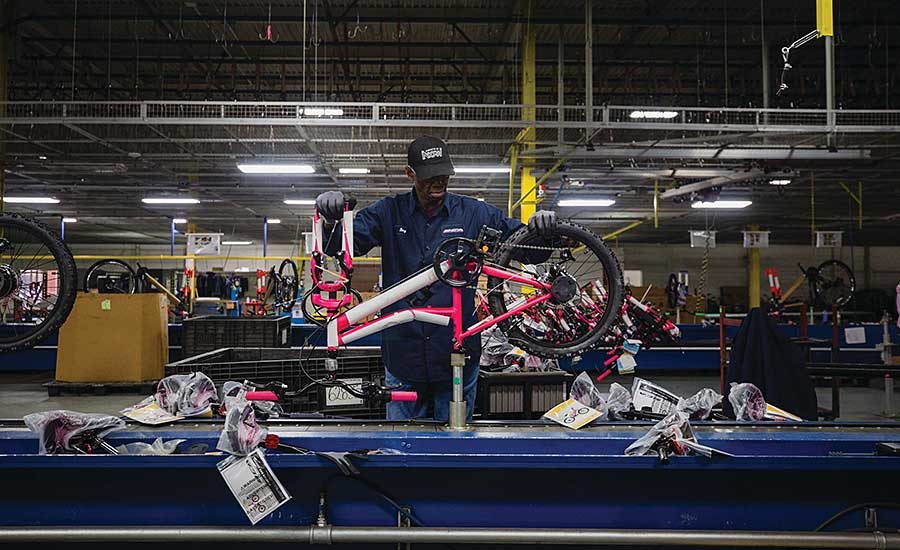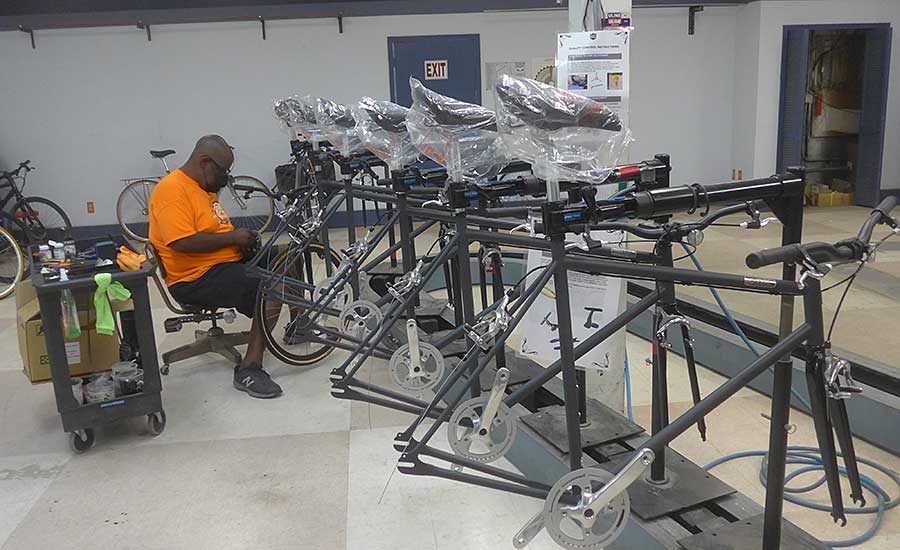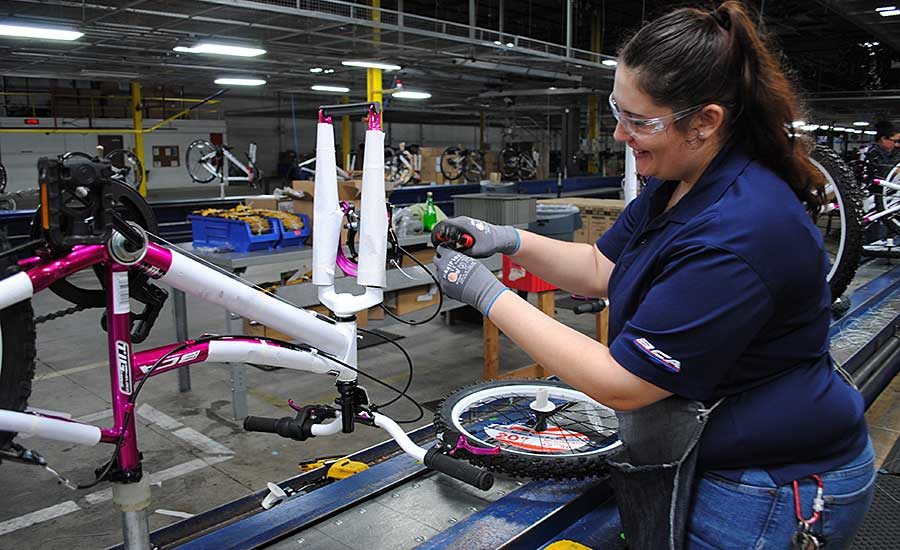The bicycle industry has emerged as one of the few beneficiaries of the coronavirus pandemic, as people search for ways to stay active, entertain children and commute to work. By some estimates, bicycle sales nationwide surged by 50 percent last year. That’s great news for domestic bike manufacturers, like Detroit Bikes and Bicycle Corp. of America (BCA).
Once upon a time, the United States was the world’s leading producer of bicycles. Companies such as Huffy, Murray and Schwinn operated factories that mass-produced bikes every year. While those brands still exist, production went overseas years ago.
For instance, Schwinn made its last bicycle in Chicago in 1982 and Huffy closed its flagship factory in Celina, OH, in 1998. In between, many other well-known American bike makes, such as Roadmaster and Ross, followed in their footsteps. At the time, retail prices of bicycles had plunged by 25 percent as Asian manufacturers drove down prices and eroded profit margins.
According to Harry Moser, president of the Reshoring Initiative and author of ASSEMBLY’S “Moser on Manufacturing” column, U.S. manufacturers produced more than 5 million bikes in 1990. However, as more offshoring activity occurred, domestic production fell to a low of 200,000 units in 2015. The majority of those bikes were made by low-volume, niche companies that cater to hard-core cycling enthusiasts.
Bicycle manufacturing tends to be a cyclical industry that experiences dramatic booms and busts. In fact, the downward spiral in domestic production has been reversed in recent years, due to a number of factors.
Whether mobile or stationary, bikes offer numerous health benefits. Because of the coronavirus pandemic, many people are rethinking where they exercise and how they spend their leisure time.
“[Last year] consumers [were] looking for outdoor- and kid-friendly activities to better tolerate the challenges associated with stay-at-home orders, and cycling fits the bill well,” says Dirk Sorenson, sports industry analyst at NPD Group Inc., a research firm that tracks market trends. “Ultimately, more people are [riding bikes] today than in years past.
“Sales for the first quarter of 2021 were up 83 percent from the same time period one year ago,” claims Sorenson. “Interest in the purchase of bicycles remains high among consumers.” That trend is expected to continue for the next year or two.
In urban environments, bikes are popular for short-distance commutes, because they save considerable time compared to other transportation options. And, bicycles address increasingly important issues such as limited parking spaces, air pollution and traffic congestion. In addition, bike-sharing systems enable people to rent a bicycle and easily cruise around cities on two wheels.
Increased interest in electric vehicles is also driving the bike boom. In fact, many bicycle manufacturers are equipping their products with compact, lightweight batteries, motors and drive systems that supplement good old-fashioned pedal power.
“Sales of e-bikes have shown significant growth,” notes Sorenson. “With the pandemic bringing more riders to the activity, e-bike sales accelerated. Within specialty bicycle shops, e-bikes now represent the third largest bike category, trailing only mountain bike and road bike sales.”
“E-bikes have been quite the boom,” adds Chase Spaulding, an instructor at Minnesota State College Southeast who specializes in bicycle design and fabrication. His two-year program at the community college recently graduated its first class. Spaulding set up the program to meet the needs of local bike manufacturers such as Hed Cycling Products, Quality Bicycle Products and Trek Bicycle Corp.
“The auto sector pushing so rapidly into electric vehicles has helped the cycling industry make great strides without having to bear the entire costs of developing batteries and other components,” says Spaulding. “[These parts can easily be integrated into] an end product most [people] feel safe on and wouldn’t just view as a very odd form of moped or motorcycle.”
According to Spaulding, gravel bikes are another hot segment of the industry. They appeal to cyclists who like to keep going where the road ends. They are a cross between mountain and road bikes, but offer a unique riding experience.
Competitive Industry
Once upon a time, most bikes were sold through neighborhood bike dealers and large retailers, such as Sears, Roebuck & Co. or Montgomery Ward & Co. While local bike shops still exist, most now specialize in high-end products for serious cyclists.
Today, the majority of mass-market bikes are sold through large retailers, such as Dick’s Sporting Goods, Target and Walmart, or via e-commerce sites such as Amazon. Direct-to-consumer sales have also transformed the bike industry in recent years as more people purchase products online.
China and Taiwan dominate the global bike market, with companies such as Giant, Merida and Tianjin Fuji-ta accounting for big chunks of the business. Most components are also produced overseas by companies such as Shimano, which controls two-thirds of the market for gears and brakes.
In Europe, northern Portugal is the center of the bike industry. More than 50 companies in the region produce bicycles, parts and accessories. Europe’s largest bike manufacturer, RTE, operates a factory in Serzedo, Portugal, that can assemble up to 5,000 bicycles a day.
Today, the Reshoring Initiative claims there are more than 200 U.S. bicycle manufacturers and brands, ranging from Alchemy Bicycle Co. to Victoria Cycles. While many are small companies or distributors, there are several major players, including BCA (a subsidiary of Kent International Inc.) and Trek. However, many firms, such as Ross Bikes and SRAM LLC, design products domestically and manufacture overseas.
For instance, Ross products are designed in Las Vegas but produced in China and Taiwan. Between 1946 and 1989, the family-owned company operated factories in Brooklyn, NY, and Allentown, PA, that mass-produced bikes before ceasing operations.
“We would love to make bikes in the U.S. again, but 90 percent of components, such as derailleurs (the mechanical mechanisms responsible for moving the chain between sprockets to change gears) are produced overseas,” says Shaun Ross, a fourth generation member of the family who recently resurrected the brand that pioneered mountain bikes in the 1980s. “However, we may eventually do some custom, low-volume production here.”
Although some materials have changed, the basic process of assembling bicycles has remained virtually the same for decades. Painted frames are mounted on fixtures and then various components, such as brakes, fenders, gears, handle bars, pedals, seats and wheels are attached. Handle bars are usually removed prior to shipping to enable bikes to fit into narrow cartons.
Frames typically consist of a variety of tubular metal components that are bent, welded and painted. Aluminum and steel are the most commonly used materials, but carbon-fiber composite and titanium frames are also used on high-end bicycles, due to their light weight.
Complex Products
To a casual observer, most bikes look and perform the same way as they have for decades. However, there are now more options available than ever.
“In general, the market has more competition in terms of designs for frames and components,” says Minnesota State College Southeast's Spaulding. “Mountain bikes have diversified, and gone from high, tight and nimble, to long, low and slack, with multiple options today everywhere in-between. Road biking has less diversity, but is far more granular and razor’s edge in the differences in components, geometry, weight and performance.
“Derailleurs are the most complex component on nearly all bikes today,” explains Spaulding. “You also see some internally geared hubs that pack anywhere from two to 14 gears into the hub of the rear wheel, but are far less pervasive due to their increased cost and complexity, without commensurate performance dividends.
“Frames themselves are another one, as much like the footwear industry, you’re building a sized product to meet different shapes,” Spaulding points out. “But, beyond the challenge shoes face of static sizing, the frame must not only fit the user, but maintain performance, comfort and strength throughout that sizing range.
“So, while often just an assemblage of a few metal or carbon fiber shapes, the complexity of geometric variables at play can make developing a frame, especially from scratch, more challenging than a single assembly of greater component density and complexity may be,” claims Spaulding. “The angle and position of components can have an amazing difference on performance.”
“The typical bill of materials on a bike consists of about 40 basic items that come from around 30 different suppliers,” adds Zak Pashak, president of Detroit Bikes Inc. His 10-year-old company is based in an unmarked brick building on the West Side of Detroit that formerly housed a sign company.
The 50,000-square-foot facility is unique, because it hand-builds entire bicycles, including frames and wheels, from start to finish. Production volume currently averages around 50 bikes per day on two assembly lines, but the factory has the capacity to produce up to 300 bikes daily. A worldwide parts shortage that is crippling the entire bike industry is preventing the company from ramping up volume.
Back to the Future
In addition to producing its own brand, including the popular Sparrow commuter model, Detroit Bikes serves as a contract manufacturer. It has assembled bikes for Dick’s Sporting Goods, plus custom fleets for brands such as Faygo, New Belgium Brewing and Toll Brothers. When Schwinn recently celebrated its 125th anniversary, Detroit Bikes produced a special run of 500 Collegiate models.
According to Pashak, most bike frames are produced overseas. However, his 10-year-old company is unique in the industry because it assembles made in the USA frames out of chromoly steel. Most domestic bike manufacturers use frames that they import. Other components, such as tires and wheels, are also imported.
“We have steel fabrication capabilities in-house that enable us to produce any type of bike,” explains Pashak. “The process starts with raw steel tubes that are cut and bent into various shapes and sizes. Those tubular parts are then put in jigs and manually welded together to make a bike frame.
“Brackets that hold cables for brakes and gears are also welded onto frames before the entire assembly is painted,” says Pashak. “The bike industry is moving toward more automation, but we currently do things the old-fashioned way, because we don’t have the volume to justify investing in automated machinery.”
Even the largest bike factory in America makes limited use of automation, but that’s about to change. BCA’s seven-year-old plant in Manning, SC, is housed in a 204,000-square-foot facility that produces mass-market bicycles for Amazon, Home Depot, Target, Walmart and other customers. It features two moving assembly lines—one for single-speed bikes and one for multispeed bikes—that can produce up to 1,500 units a day, plus a state-of-the-art powder coating paint shop.
BCA also operates a 146,000-square-foot assembly plant that is located a few miles away. It specializes in custom bikes and products with smaller production runs that are built on a manual assembly line. However, BCA produces most of its products in Southeast Asia.
“Despite everything that we’re doing in South Carolina, it only amounts to about 15 percent of our revenue,” says Arnold Kamler, CEO of Kent International. “We still need to import virtually all of the parts that we assemble. But, we are in the process of making frames, forks, handlebars and wheel rims in the United States.
“In order for it to work, however, our new facility will have to be highly automated,” explains Kamler. “We’re currently shopping for the equipment that we’ll need. We plan to have the facility operating within two years.
“Our goal is to cut down on lead times,” notes Kamler, who has worked in his family-owned company for 50 years. “We want to be able to make a commitment to particular models 30 days before we need to. Right now, because of the offshore supply chain, we have to make decisions and order parts up to six months in advance.”
“To be successful long term, we need to add more automation,” claims Kamler. “We already have some wheel building automation in our factory. For instance, we have a machine that inserts spokes into hubs and another machine that trues the wheel.
“But, on the other side of the factory, the assembly line is still way too manual and not much different than the way it was 40 years ago,” says Kamler. “We’re currently working with several universities to address this issue. We hope to have robots in use for some applications within the next two years.”
“We are seeing more interest in robots from bicycle manufacturers today, especially companies that are producing stationary bikes and e-bikes, which tend to be heavier,” adds James Cooper, executive director of global accounts at Fanuc America Corp. “As with many industries, reshoring activity in the bike business will spur increased demand for automation in the future.”
ASSEMBLY ONLINE
For more information on bicycle manufacturing, click on these other ASSEMBLY articles:
- Adhesives Assemble Motors for Electric Bike
- New Materials Spur Innovation in Sporting Goods Manufacturing
- Optimizing Bicycle Component Designs











